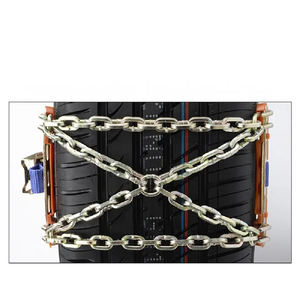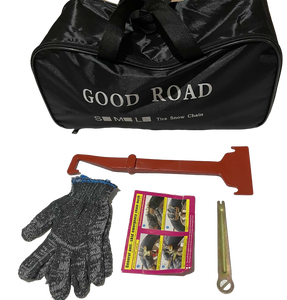(306 products available)


























































































































































































Tire chains for small cars are generally categorized according to the material used to make them and the design of the links. The material determines the performance and durability of the chains, while the link design affects the traction and ease of installation.
Material
The most common materials for tire chains are steel and cable. Steel chains are very durable and offer excellent traction on ice and snow. They are the most common type of tire chains for small cars. Cable chains are lighter and easier to install. However, they do not provide as much traction or durability as steel chains.
Link Design
Link designs vary depending on the intended use of the tire chains. The most common types are square link, round link, and V-bar chains. Square link chains have square-shaped links that offer good traction on icy roads. They are very popular in regions that experience heavy snow. Round link chains have round links that are better suited for driving on snow-packed roads. V-bar chains have links arranged in a V shape. They are designed for driving on ice and provide excellent traction. However, V-bar chains can damage the road surface.
Size
Properly sized tire chains for small cars are crucial for safety and performance. Chains that are too loose may fall off or get stuck in the road, while overly tight chains can damage the tires or the vehicle. Here are some factors that determine the correct size:
Chain size must correspond to the tire size. The tire's width, aspect ratio, and diameter are used to determine the perfect chain size. For instance, a 195/65R15 tire chain specification shows a width of 195 mm, an aspect ratio of 65%, and a 15-inch diameter. This data is critical when selecting the correct chain size.
Material
Tire chains are constructed from different materials, each with unique properties and advantages:
Steel: Steel chains are the most common. They provide durability and excellent traction in icy conditions. Some chains, however, have steel links coated with other materials like tungsten carbide, which improves longevity.
Link designs
Link designs affect the performance of tire chains:
Square links: Square links have a traditional design and provide a stable grip on ice and snow. The design, however, causes minor road damage.
Round links: They are more modern and gentle on the road. They are suitable for all types of terrain.
V-bar links
V-bar links have a unique design with a bar forming a V shape. The design offers excellent traction in tough conditions. The links, however, create more road damage than square or round links.
Chain patterns
Chain patterns influence how well a small car tire chain grips the road:
Diamond pattern: In this design, chains are arranged in a diamond shape around the tire. The design provides excellent traction and stability on icy or snowy surfaces.
Square pattern: The chains are arranged in a square pattern around the tire. The design offers more grip but can be a little noisy and cause minor road damage.
Triple''s pattern
Some tire chains have a triple''s pattern, where three sets of chains are arranged in a triangular shape around every tire. The design gives maximum grip but may reduce the tire's efficiency.
Installation and adjustment
Installing tire chains correctly for small cars is key to safety and performance:
Follow the manufacturer's instructions for installing and adjusting tire chains. Make sure the chains fit snugly around the tires but are not overly tight. Drive slowly for the first few minutes with the chains installed. Check the fit and make any adjustments as needed.
Maintaining tire chains for small cars is essential to ensure longevity and optimal performance.
1.
After every use, clean the chains with fresh water to remove dirt, ice, and snow. This process helps prevent rust and build-up that can affect performance.
2.
Inspect the chains regularly for signs of wear, damage, or broken links. Replace or repair as necessary to maintain the proper function and safety of the chains.
3.
Store tire chains in a dry, cool place away from sunlight and extreme temperatures. Proper storage prevents damage and extends chain life.
4.
Lubricate the chains periodically with a light oil or chain lubricant. This process reduces friction, prevents rust, and ensures smooth operation.
5.
Avoid driving on dry pavement with tire chains, as this can cause premature wear and damage. Use the chains only in snowy or icy conditions where traction is needed.
When buying tire chains for small cars, retail buyers should consider the following factors:
Check Tire Size
To get the right chains for a small car, check the car's tire size. The size is printed on the sidewall of the tires. It should look something like this: 195/65R15. The numbers and letters are important. They represent the width, aspect ratio, and diameter of the tires. The chains must match the size exactly to fit properly and safely.
Think About the Material
The links of tire chains are made from different materials depending on the type of chain. Common materials include steel, tungsten, and nylon. Steel chains are the most durable. Tungsten is for very high-performance applications where maximum grip is needed. Nylon or other synthetic materials work for light-duty use. Remember that synthetic options last longer than steel.
Consider Driving Conditions
Where and how the small car will be driven affects chain selection. For mostly highway driving in winter, low-profile chains that minimize vibration at high speeds are best. If the car will be in deep snow or ice terrain, heavy-duty chains with more aggressive tread patterns provide better traction. Balance needs with how often chains will be installed/removed.
Check Clearance Issues
Small cars often have less wheel well clearance than larger vehicles. Before purchasing, measure the distance between the tire and any components like the suspension, brakes, or bodywork. The new chains need adequate clearance to avoid damage when driving. Look for chains specifically designed for cars with tight clearances.
Look for Easy Installation
Tire chains can be tricky to put on properly. For small cars, especially first-time users, choose chains that are quick and easy to install correctly. Models with color-coded tensioning systems or instructional videos are helpful. Some brands have self-tightening mechanisms that stay snug during driving. This is convenient and ensures maximum grip.
Check Legal Restrictions
Some areas have laws about using tire chains. For example, certain states in the USA require chains only when there are snow signs. Or, there may be rules about how much a chain can stick out past the tire. Retail buyers should research any restrictions by location. Choose chains that comply with local regulations to avoid fines and safety issues.
Consider Storage Space
Tire chains take up room when not in use. For small cars with limited trunk space, look for bags or cases that protect the chains when stored. Some cases attach to the outside of a vehicle for more compact storage. Folding links and other design features help keep chains neat when not on the tires. Measure available storage area before buying.
Here are some steps for properly installing and replacing tire chains for small cars:
1. Prepare the car and chain
Find a flat and level place to install the chains. Turn on the hazard lights and make sure the brake is set. Lay the chains out on the ground and untangle any twists or knots. Ensure the chains are not twisted and are properly oriented.
2. Position the chain
Small car owners should park the car in a flat area and set the parking brake. They should lay the chain on the ground parallel to the tire. The side with the fasteners should be close to the tire. Ensure the chain is not twisted and lays flat.
3. Slide the chain under the tire
Small car owners should slide the inner part of the chain under the tire. Ensure it is even and lies flat. Then, roll the car ahead by a few feet so the chain can be fully installed on the back part.
4. Connect the chain
Connect the two ends of the chain and ensure it is even. The tensioning system should be on the side of the small car owner. Follow the manufacturer's instructions to ensure the tension is just right.
5. Check the tension
Small car owners should drive a few miles and stop to check the chains. Ensure the tension is still correct and tighten it if necessary. Replace the chains if they are worn out or damaged beyond repair.
Q1: Are tire chains only used for snowy conditions?
A1: No, tire chains can be used in different situations, such as icy roads, rocky terrains, and off-road conditions where extra traction is needed.
Q2: Can all small cars use tire chains?
A2: Not all small cars can use tire chains. Some small cars with limited wheel clearance may not have enough room to accommodate chains. It's essential to check the vehicle's owner's manual or consult with the manufacturer.
Q3: Can tire chains be installed on the rear tires of front-wheel-drive small cars?
A3: Yes, for front-wheel-drive small cars, installing tire chains on the rear tires is possible. However, installing them on the front tires for optimal traction and control is recommended.